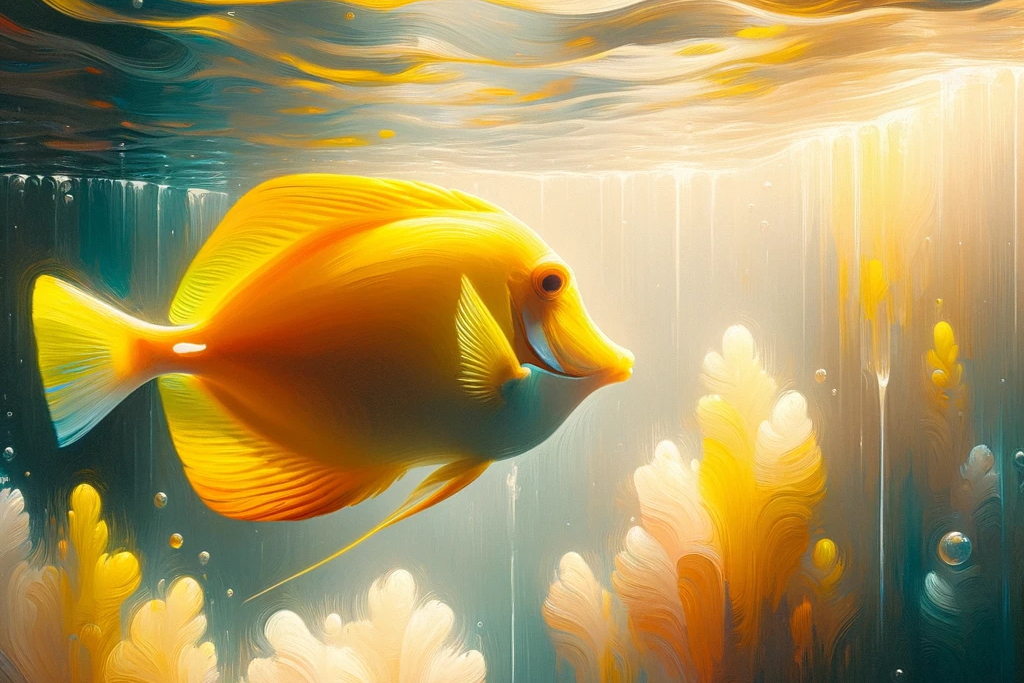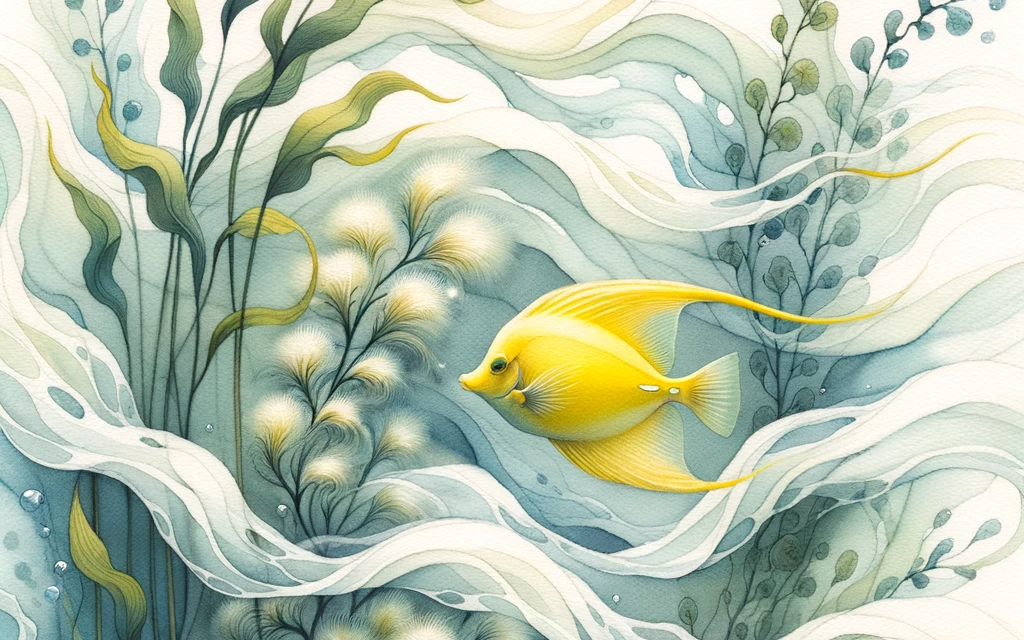To start learning about the care of a Yellow Tang, it’s important for you to understand the basics of their introduction to your aquarium. Yellow Tangs are known for their vibrant color and playful behavior, making them a popular choice among aquarium enthusiasts. However, it’s crucial to create a suitable habitat for them to thrive.
Yellow Tangs are native to the reefs of the Pacific Ocean, particularly around Hawaii. They’re accustomed to living in warm, tropical waters with plenty of coral and rocks for shelter. When introducing a Yellow Tang to your aquarium, it’s important to recreate their natural habitat as closely as possible. This means providing ample swimming space, live rock formations, and a temperature of around 75 to 82 degrees Fahrenheit.
When it comes to behavior, Yellow Tangs are generally peaceful, but they can become territorial towards other fish of the same species or similar appearance. It’s recommended to introduce them to the aquarium last, once the other fish have established their territories. Additionally, Yellow Tangs are herbivores and require a diet rich in algae. Providing them with a variety of seaweed and algae-based foods will help keep them healthy and happy.

Life Expectancy
The average lifespan of a Yellow Tang in captivity is typically 8 to 12 years. As a pet owner, it’s important to understand the average lifespan of your Yellow Tang so that you can provide the best care possible. It’s also essential to be aware of common health issues that can affect these beautiful fish. While Yellow Tangs are generally hardy and resilient, they can still be susceptible to certain ailments.
One of the most common health issues that Yellow Tangs may face is marine ich, which is a parasitic infection. This condition can cause white spots to appear on their body and fins, leading to irritation and discomfort. Another common issue is lateral line erosion, which results in the deterioration of the fish’s lateral line. This can be caused by poor water quality or a lack of proper nutrition.
To ensure that your Yellow Tang lives a long and healthy life, it’s crucial to maintain excellent water quality in their tank. Regular water testing, proper filtration, and frequent water changes are essential. Additionally, providing a balanced diet that includes a variety of foods, such as algae-based pellets and fresh vegetables, can help prevent nutritional deficiencies.
Water Needs
Maintaining proper water quality is vital for the health and well-being of your Yellow Tang. To ensure a healthy environment for your fish, it’s important to have an effective filtration system in place. A good filtration system helps remove impurities and keeps the water clean and clear. It consists of mechanical, chemical, and biological filtration components.
Mechanical filtration involves removing debris and particulate matter from the water. This can be achieved through the use of filter pads or sponges that trap larger particles.
Chemical filtration helps to remove toxins and chemicals from the water. Activated carbon is commonly used for this purpose, as it absorbs impurities and odors.
Biological filtration is crucial for establishing a stable and healthy aquarium. It involves the growth of beneficial bacteria that break down harmful substances such as ammonia and nitrite into less toxic forms. To establish the biological filtration, it’s important to go through the process of tank cycling. This involves allowing the tank to mature and the beneficial bacteria to establish themselves before adding any fish.
Regular monitoring of water parameters such as temperature, pH, ammonia, nitrite, and nitrate levels is necessary to maintain a stable and healthy environment for your Yellow Tang. Regular water changes, typically around 10-20% every two weeks, help to dilute any accumulated pollutants and maintain good water quality.

Tank Arrangement
When arranging the tank for your Yellow Tang, it’s important to consider their natural habitat and provide suitable hiding places. Yellow Tangs come from the coral reefs of the Pacific Ocean, where they swim among coral formations and hide in crevices. To recreate this environment in your tank, you can add decorative items such as live rock, which provides both hiding places and a natural appearance. Other options include artificial corals or PVC pipe structures that mimic the look and feel of a reef. These hiding places are essential for the well-being of your Yellow Tang, as they help reduce stress and provide a sense of security.
In addition to hiding places, lighting options are another important aspect to consider. Yellow Tangs are used to bright, tropical sunlight in their natural habitat, so providing proper lighting is crucial for their health. LED lights are a popular choice among hobbyists, as they’re energy-efficient and can be adjusted to mimic the intensity and spectrum of natural sunlight. This won’t only enhance the colors of your Yellow Tang but also promote the growth of beneficial algae, which is an important part of their diet.
Compatible Tank Mates
To ensure a harmonious tank environment, consider adding a small number of compatible tank mates for your Yellow Tang. When selecting tank mates, it’s important to consider the tank size and aggression levels of the fish. Yellow Tangs are known to be territorial and can become aggressive towards other fish that invade their space. Therefore, it’s best to choose tank mates that are peaceful and can withstand the Yellow Tang’s territorial behavior.
In terms of tank size, it’s recommended to have a larger tank to accommodate both the Yellow Tang and its tank mates. A tank size of at least 75 gallons is recommended to provide enough swimming space for multiple fish. This will help reduce aggression and ensure that all fish have enough room to establish their territories.
When it comes to aggression levels, it’s important to choose tank mates that are known to be peaceful and can coexist with the Yellow Tang. Some suitable tank mates include peaceful damselfish, gobies, and wrasses. Avoid adding fish that are known to be aggressive or territorial, as this can lead to conflicts and stress for the Yellow Tang.
Remember to introduce new tank mates slowly and monitor their interactions closely. This will help ensure a peaceful and harmonious tank environment for your Yellow Tang and its compatible tank mates.
Diet
Feed your Yellow Tang a balanced diet to ensure its health and vitality. Understanding the feeding habits and nutritional requirements of your Yellow Tang is crucial for its well-being. Yellow Tangs are herbivores, primarily feeding on algae in the wild. Therefore, it’s essential to provide them with a diet rich in plant matter.
To meet their nutritional needs, offer your Yellow Tang a variety of marine-based foods. This can include specially formulated spirulina-based flakes or pellets, which mimic their natural diet. Additionally, you can supplement their diet with fresh or frozen algae, such as nori or dried seaweed. These can be attached to a clip inside the aquarium, allowing your Yellow Tang to graze on it throughout the day.
It is important to note that Yellow Tangs have high metabolic rates and require frequent feedings. Aim to feed them small amounts multiple times a day to prevent overeating and maintain optimal health. Monitor their intake and adjust the feeding schedule accordingly.
Reproduction
To successfully breed Yellow Tangs in your aquarium, it’s important to create the optimal conditions for reproduction. Understanding their breeding habits and spawning behavior will help you provide the best environment for your tangs to reproduce.
Yellow Tangs are known to be pelagic spawners, meaning they release their eggs and sperm into the water column rather than depositing them on a substrate. They typically spawn in groups, with multiple individuals releasing their reproductive products simultaneously. This behavior increases the chances of successful fertilization and survival of the offspring.
Creating the right conditions for breeding involves maintaining proper water parameters, including temperature, salinity, and pH. Yellow Tangs prefer water temperatures between 75°F and 82°F, a salinity level of around 1.025, and a pH range of 8.1 to 8.4. It’s also essential to provide ample hiding places, such as rocky crevices or live rock, for the tangs to lay their eggs.
Once the eggs are released, they’ll hatch into larvae within 24 to 48 hours. These larvae are highly sensitive and require specialized care. Providing suitable food, such as copepods or phytoplankton, is crucial for their development and survival.
Conclusion
In conclusion, taking care of a yellow tang requires attention to their specific needs.
With a life expectancy of up to 20 years, providing them with a well-maintained tank and suitable tank mates is crucial.
Regular monitoring of water conditions and providing a balanced diet will contribute to their overall health and well-being.
By following these care guidelines, you can ensure a happy and thriving yellow tang in your aquarium.

